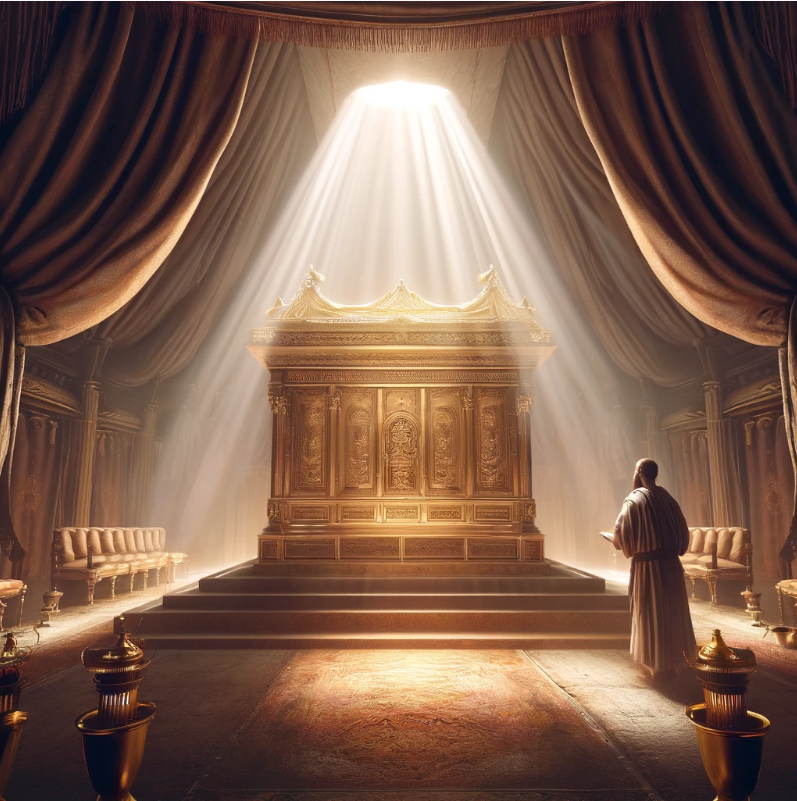
The term «Mercy Seat» is mentioned in several places in the Bible, primarily in the Old Testament. Notably, it appears in Exodus 25:17-22, where God instructs Moses on how to construct the Mercy Seat as the lid of the Ark of the Covenant. It is also referenced in Leviticus 16:2, in the context of the Day of Atonement rituals.
Exodus 25:17-22
And thou shalt make a mercy seat of pure gold: two cubits and a half shall be the length thereof, and a cubit and a half the breadth thereof. And thou shalt make two cherubims of gold, of beaten work shalt thou make them, in the two ends of the mercy seat. And make one cherub on the one end, and the other cherub on the other end: even of the mercy seat shall ye make the cherubims on the two ends thereof. And the cherubims shall stretch forth their wings on high, covering the mercy seat with their wings, and their faces shall look one to another; toward the mercy seat shall the faces of the cherubims be. And thou shalt put the mercy seat above upon the ark; and in the ark thou shalt put the testimony that I shall give thee. And there I will meet with thee, and I will commune with thee from above the mercy seat, from between the two cherubims which are upon the ark of the testimony, of all things which I will give thee in commandment unto the children of Israel.
Exodus 25:17-22
Leviticus 16:2
And the Lord said unto Moses, Speak unto Aaron thy brother, that he come not at all times into the holy place within the vail before the mercy seat, which is upon the ark; that he die not: for I will appear in the cloud upon the mercy seat.
Leviticus 16:2
What does the mercy seat mean in the Bible?
In the Bible, the mercy seat is a very special and sacred part of the Tabernacle, where God promised to meet with Moses and speak with him. You can think of it like a designated spot where God’s presence would be visible in a cloud and where He would communicate directly with His chosen leaders. This was not just any piece of furniture; it was made of pure gold and was placed right on top of the Ark of the Covenant.
The Ark of the Covenant itself held important items like the stone tablets of the Ten Commandments, a pot of manna, and Aaron’s rod that budded. These items were reminders of God’s covenant with Israel, His promises, and His provision.
The mercy seat was designed to be beautiful and awe-inspiring. It had two golden cherubim (angelic figures) at each end. These cherubim faced each other and looked down at the mercy seat with their wings spread out above it. The detailed craftsmanship showed how important and holy this place was.
Every year, on the Day of Atonement, the high priest entered the Holy of Holies, where the mercy seat was kept. He did not do this casually; it was a solemn and sacred moment, for it was here on the mercy seat that the blood of a sacrificed animal was sprinkled. This act was a symbol of God’s forgiveness of sins for the people. It was called the mercy seat because it was the place where God’s mercy was shown through the forgiveness of sins.
To understand the mercy seat is to understand God’s deep desire for a relationship with His people — one marked by forgiveness and mercy. The presence of God on the mercy seat symbolized His throne in heaven, making the mercy seat a vital point of contact between God and man.
This concept of mercy and meeting with God is crucial because it emphasizes that God is both holy and merciful. He provided a way for the Israelites to receive forgiveness and maintain their relationship with Him, through the practices centered around the mercy seat. In this way, the mercy seat represents God’s ultimate plan of salvation and grace towards humanity, fulfilled in Jesus Christ, who is believed by Christians to be the ultimate high priest and sacrifice.
